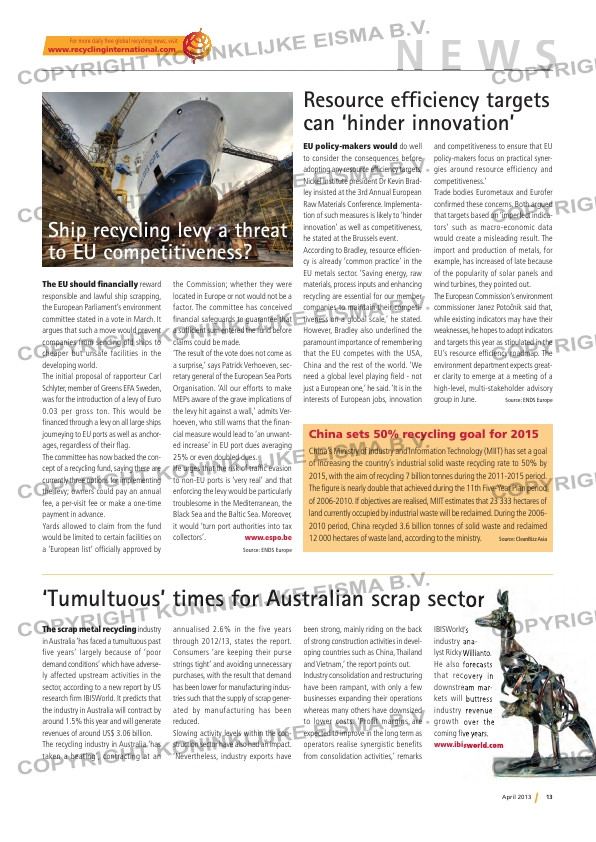Page 13 from: April 2013

N E W S
13April 2013
For more daily free global recycling news, visit
www.recyclinginternational.com
China sets 50% recycling goal for 2015
China’s Ministry of Industry and Information Technology (MIIT) has set a goal
of increasing the country’s industrial solid waste recycling rate to 50% by
2015, with the aim of recycling 7 billion tonnes during the 2011-2015 period.
The fi gure is nearly double that achieved during the 11th Five-Year Plan period
of 2006-2010. If objectives are realised, MIIT estimates that 23 333 hectares of
land currently occupied by industrial waste will be reclaimed. During the 2006-
2010 period, China recycled 3.6 billion tonnes of solid waste and reclaimed
12 000 hectares of waste land, according to the ministry. Source: CleanBizz Asia
‘Tumultuous’ times for Australian scrap sector
The scrap metal recycling industry
in Australia ‘has faced a tumultuous past
five years’ largely because of ‘poor
demand conditions’ which have adverse-
ly affected upstream activities in the
sector, according to a new report by US
research fi rm IBISWorld. It predicts that
the industry in Australia will contract by
around 1.5% this year and will generate
revenues of around US$ 3.06 billion.
The recycling industry in Australia ‘has
taken a beating’, contracting at an
annualised 2.6% in the five years
through 2012/13, states the report.
Consumers ‘are keeping their purse
strings tight’ and avoiding unnecessary
purchases, with the result that demand
has been lower for manufacturing indus-
tries such that the supply of scrap gener-
ated by manufacturing has been
reduced.
Slowing activity levels within the con-
struction sector have also had an impact.
‘Nevertheless, industry exports have
been strong, mainly riding on the back
of strong construction activities in devel-
oping countries such as China, Thailand
and Vietnam,’ the report points out.
Industry consolidation and restructuring
have been rampant, with only a few
businesses expanding their operations
whereas many others have downsized
to lower costs. ‘Profit margins are
expected to improve in the long term as
operators realise synergistic benefits
from consolidation activities,’ remarks
IBISWorld’s
industry ana-
lyst Ricky Willianto.
He also forecasts
that recovery in
downstream mar-
kets will buttress
industry revenue
growth over the
coming fi ve years.
www.ibisworld.com
EU policy-makers would do well
to consider the consequences before
adopting any resource effi ciency targets,
Nickel Institute president Dr Kevin Brad-
ley insisted at the 3rd Annual European
Raw Materials Conference. Implementa-
tion of such measures is likely to ‘hinder
innovation’ as well as competitiveness,
he stated at the Brussels event.
According to Bradley, resource effi cien-
cy is already ‘common practice’ in the
EU metals sector. ‘Saving energy, raw
materials, process inputs and enhancing
recycling are essential for our member
companies to maintain their competi-
tiveness on a global scale,’ he stated.
However, Bradley also underlined the
paramount importance of remembering
that the EU competes with the USA,
China and the rest of the world. ‘We
need a global level playing fi eld – not
just a European one,’ he said. ‘It is in the
interests of European jobs, innovation
and competitiveness to ensure that EU
policy-makers focus on practical syner-
gies around resource efficiency and
competitiveness.’
Trade bodies Eurometaux and Eurofer
confi rmed these concerns. Both argued
that targets based on ‘imperfect indica-
tors’ such as macro-economic data
would create a misleading result. The
import and production of metals, for
example, has increased of late because
of the popularity of solar panels and
wind turbines, they pointed out.
The European Commission’s environment
commissioner Janez Potočnik said that,
while existing indicators may have their
weaknesses, he hopes to adopt indicators
and targets this year as stipulated in the
EU’s resource effi ciency roadmap. The
environment department expects great-
er clarity to emerge at a meeting of a
high-level, multi-stakeholder advisory
group in June. Source: ENDS Europe
Resource efficiency targets
can ‘hinder innovation’
The EU should fi nancially reward
responsible and lawful ship scrapping,
the European Parliament’s environment
committee stated in a vote in March. It
argues that such a move would prevent
companies from sending old ships to
cheaper but unsafe facilities in the
developing world.
The initial proposal of rapporteur Carl
Schlyter, member of Greens EFA Sweden,
was for the introduction of a levy of Euro
0.03 per gross ton. This would be
fi nanced through a levy on all large ships
journeying to EU ports as well as anchor-
ages, regardless of their fl ag.
The committee has now backed the con-
cept of a recycling fund, saying there are
currently three options for implementing
the levy; owners could pay an annual
fee, a per-visit fee or make a one-time
payment in advance.
Yards allowed to claim from the fund
would be limited to certain facilities on
a ‘European list’ offi cially approved by
the Commission; whether they were
located in Europe or not would not be a
factor. The committee has conceived
fi nancial safeguards to guarantee that
a suffi cient sum entered the fund before
claims could be made.
‘The result of the vote does not come as
a surprise,’ says Patrick Verhoeven, sec-
retary general of the European Sea Ports
Organisation. ‘All our efforts to make
MEPs aware of the grave implications of
the levy hit against a wall,’ admits Ver-
hoeven, who still warns that the fi nan-
cial measure would lead to ‘an unwant-
ed increase’ in EU port dues averaging
25% or even doubled dues.
He urges that the risk of traffi c evasion
to non-EU ports is ‘very real’ and that
enforcing the levy would be particularly
troublesome in the Mediterranean, the
Black Sea and the Baltic Sea. Moreover,
it would ‘turn port authorities into tax
collectors’. www.espo.be
Source: ENDS Europe
Ship recycling levy a threat
to EU competitiveness?
RI-3_NEWS.indd 13 08-04-13 09:22



